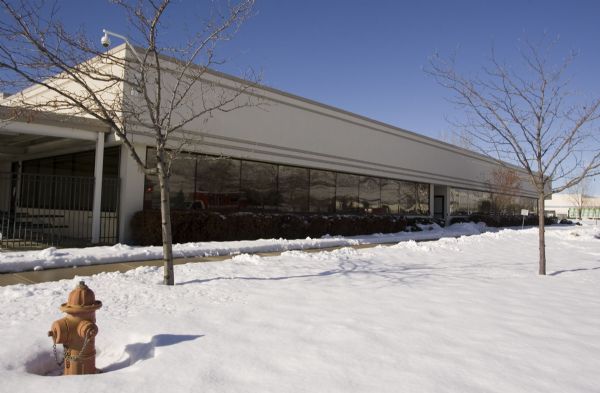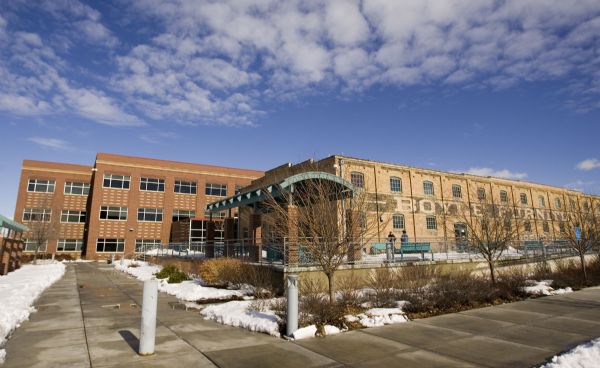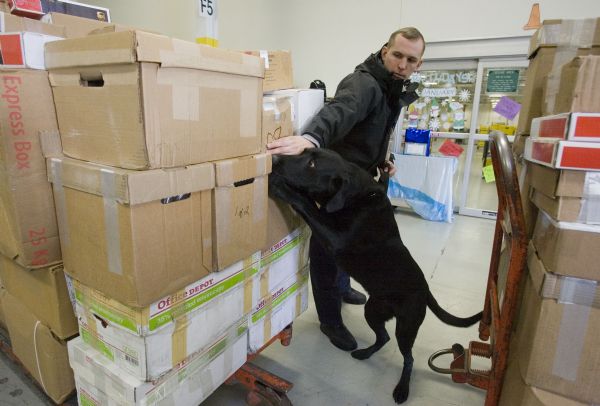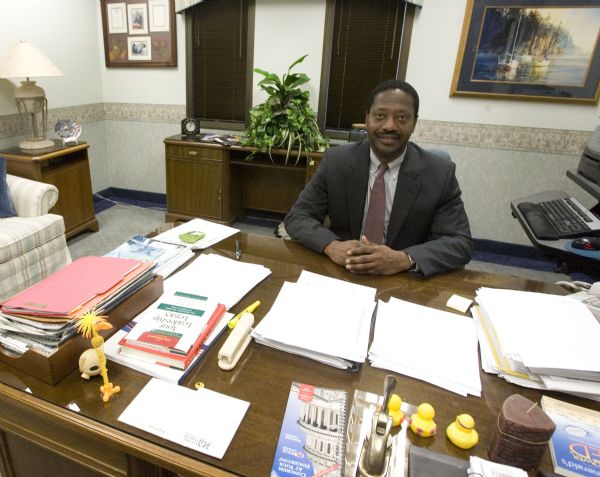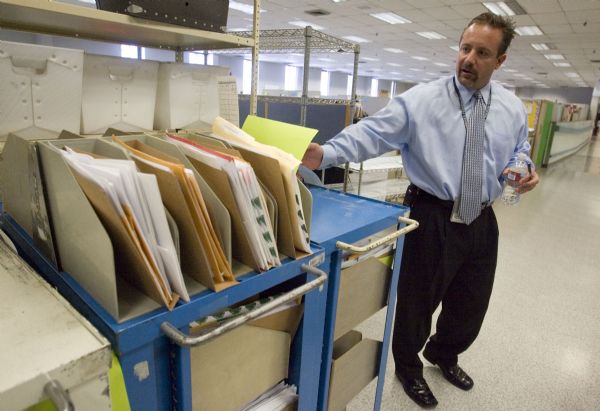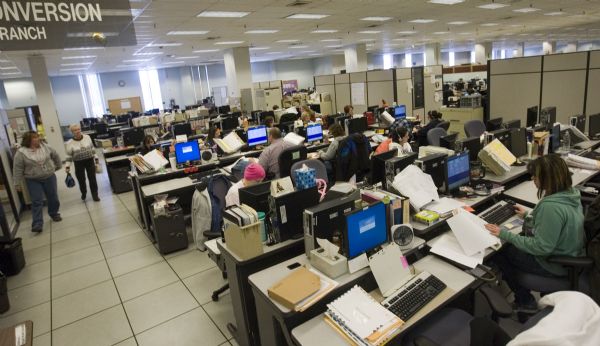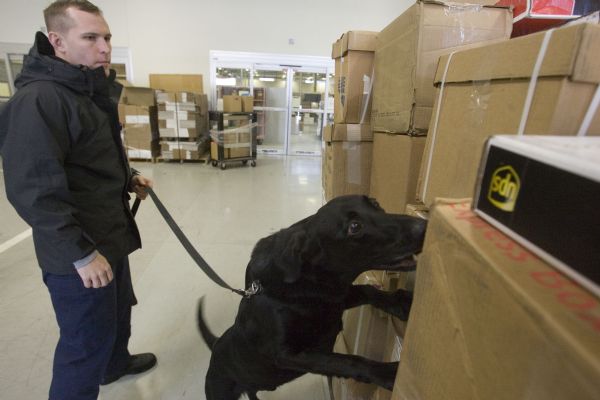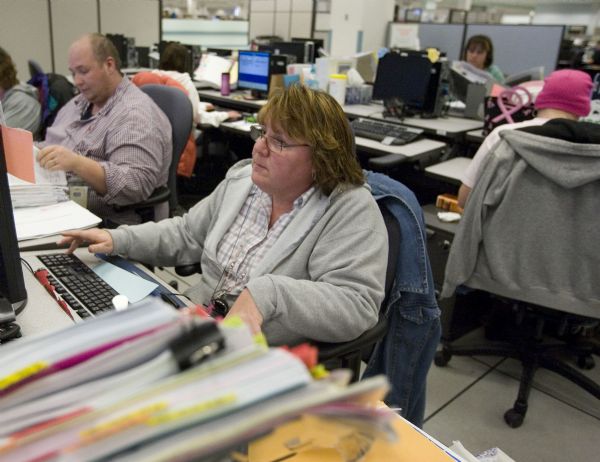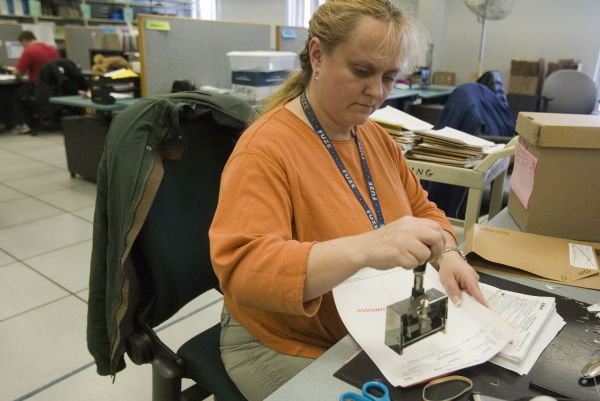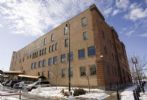This is an archived article that was published on sltrib.com in 2010, and information in the article may be outdated. It is provided only for personal research purposes and may not be reprinted.
Ogden » Depending on the time of year, up to 7,000 people draw paychecks in or around the Internal Revenue Service campus. At least 6,500 are full time, with the rest seasonal workers brought in during tax-crunch time.
In this northern Utah community, they call that impact, impact of the best kind.
The collection of data sorters, inputters, fact checkers, analysts and customer-service personnel who process mountains of material each year account for a total annual payroll of about $270 million, not counting benefits.
Salaries in the three Ogden-based divisions range from $35,432 to $46,676, compared with the Weber County average of $32,600.
The significance is not lost on Dave Hardman, president and CEO of the Ogden/Weber Chamber.
"They live here and spend their money here," he said. "We get six or seven turns on that money" flowing over and through businesses after business. "The IRS helps keep us vibrant."
As one of the 15 largest employers in the state, the agency's economic impact on Weber County measures in the tens of millions of dollars annually. But its influence goes well beyond the financial level as its employees do the important work of handling returns and dealing with taxpayers.
IRS employees are spread out, well beyond the sprawling main headquarters just off 12th Street at 1200 West. At least 12 buildings -- a combination of new, restored and existing -- house a variety of workers in a general area between 12th and 25th streets.
Ogden Mayor Matthew Godfrey appreciates the dollar impact but also looks at how the IRS presence has helped bring new life to the downtown of Utah's seventh-largest city. Many of the downtown buildings are new, in an area targeted for redevelopment; others are historic and have been restored by the General Services Administration.
Now in his third term, Godfrey said when he was first elected in 2000, he was told by city employees that the IRS was backing off a downtown expansion because "there was nothing there that met their needs."
"We continued to pursue them, and found two administrative orders [that require federal agencies] to give preference to urban centers and historic buildings" when searching for office space. "They weren't excited about it at first, but eventually they came along.
"They've had award-winning projects ... and they've been a significant part of our downtown redevelopment."
Tons of work » The Ogden IRS campus, with its origins back to the mid-1950s when it set up in a large warehouse on land formerly belonging to Defense Depot Ogden (now called Business Depot Ogden). Originally, the site was where taxpayers from eight western states sent their returns. Since 2000, the center has processed only business returns submitted from within an area that sweeps southeast from Minnesota to Florida covering two-thirds of the country. Business returns from the rest of the nation, principally the populous Northeast, go to a larger campus in Cincinnati.
Individual 1040 filings, including those from folks who might just live next door to the sprawling Ogden campus, go to another IRS campus in Fresno, Calif.
So, what keeps IRS workers in Ogden busy? Plenty.
In 2009, more than 65 million pieces of mail, sent by businesses ranging from Joe's Bar and Grill to some of the nation's largest corporations, arrived at the campus processing facility. Nearly $17.5 billion in checks attached to many of those returns was deposited in banks.
This volume of paper persists year after year, despite a growing movement among business and individual filers to file returns electronically, said Paul Mamo, director of submission processing -- the largest of three divisions on the Ogden campus. At age 41 and a 20-year IRS veteran, he seems unfazed by the volume handled by his 3,400 employees, many of whom he greets on a first-name basis.
"It all flows, logically and precisely," he said, standing in a cavernous room with hundreds of employees, their eyes locked on stacks of returns and their fingers rapidly transporting numbers from paper to highlighted boxes on computer screens, over and over, day in and day out.
This is the area where each business return gets a tracking number, which paradoxically is done by a human being using 50-year-old technology to rubber-stamp, by hand, each set of documents. The returns then move to the data-conversion operations area where the numbers are entered, one return at a time, into the computer system.
The task is gargantuan. There are 180 different business-tax forms that flow through the place.
If a return is incomplete, or if numbers don't add up, it goes to a specialized group in the "document-perfection" area, where analysts pour over returns to figure out what's missing. Once computerized, all that paper is transported to other buildings where it is stored and must be retrievable for years to come.
Making it all work, Mamo said, are his employees.
"The quality of the people we get here is high. We have the least attrition rate" of the 10 centers nationwide. Though internally that rate can reach 20 percent because of the entry-level nature of the jobs, it also is true that many of the division's workers can be promoted to other areas.
"We're a feeder organization for accounts management and compliance divisions," he said.
Getting up close » The compliance-services division, with 1,418 workers, is run by Henry Slaughter, whose staff deals with 57 million taxpayers, largely those associated with small businesses who are self-employed or have supplemental incomes. These employees' job is to review returns tagged with discrepancies and initiate contact with the taxpaying businesses to get discrepancies fixed or explained. This is where field audits come into play, and Slaughter directs offices in Salt Lake City, Ogden, St. George and Provo.
"We deal with returns when there are issues with it," Slaughter said. "We might ask a taxpayer to justify deductions and, on the positive side, we might catch credits that should be granted. They might not have enough W-2s attached that show all the withholding that may be due from having multiple jobs."
This process is routinely handled with letters. Sometimes it goes beyond the U.S. mail, and a face-to-face audit is required.
Generally -- and this is where IRS regional spokesman Bill Brunson steps in to the conversation -- such audits are designed to "gather statistical data. We want to make sure that audits are based on data that reflect current conditions so that the IRS's time and the taxpayer's time are not wasted," he said.
"If the data [that triggers an audit] is old ... we might audit individuals who don't need to be audited," resulting in a waste of time for the taxpayer and the IRS. "By selecting individuals for audit, the data obtained from those audits update the statistical factors."
And, of course, such audits can lead either to a change in tax owed, up or down, Brunson said.
Call after call » So, what happens when business taxpayers have questions?
That task falls to the accounts management/customer service division led by Jerry Heschel, 62, who has held just about every management position during his four decades with the IRS. He's had 16 jobs and moved 13 times over those years, and is the most-senior executive with the agency.
The customer-service part of his division involves approximately 1,600 employees who take taxpayer calls, including 300 in a small satellite center in Oakland, Calif. Those toll-free calls, no matter where the taxpayer lives, are routed through a center in Atlanta. Almost instantly, they are transferred to the appropriate center or campus -- there are 26 sites across the U.S., including one in Puerto Rico -- based on the nature of the call, where the taxpayer is located and which language the caller speaks.
Years ago, taxpayers making multiple calls to solve specific problems would have to explain, over and over, the nature of the problem to the various IRS employees. Now, Heschel said, technology has improved to where the worker taking the call can create extensive files so each caller does not have to repeatedly restate the problem.
"We're doing a much better job of taking the history. It makes a big difference to our callers," he said.
Still, even with all the technology available, the call volume is astounding. In 2009, more than 3.6 million were handled by the Ogden center -- and all those were from business taxpayers. Center personnel also dealt with 5.6 million pieces of correspondence.
Despite this crushing volume, Heschel said much of the accounts-service work involves walking small-business taxpayers through the taxpaying process -- not interpreting tax law. It can involve describing the process for getting an Employer Identification Number to more complex issues.
"We have to plan every year how to handle these numbers," Heschel said.
With 2010 just beginning, it doesn't appear there will be any letup.
"We're projecting the same as 2009," the veteran director said.
The IRS employed 6,500 to 7,000 workers at its Ogden campus, depending on the workload. They worked in three divisions:
Submission Processing, 3,400 employees, with average salary of $35,432.
Compliance Services, 1,521 employees, with average salary of $46,676.
Accounts Management, 1,760 employees, with average salary of $44,625.
The Ogden IRS campus processed 65 million pieces of mail.
The center deposited nearly $17.5 billion in checks.
Nearly 70 percent of all business returns qualified for refunds, most of which were issued within 40 to 45 days. If the taxpaying business files electronically, refunds can be made within 10 days.
In January, a nonpeak month, the center last year received nearly 5 million pieces of mail and made deposits of nearly $1.8 billion.
In the peak month of April, the center received 8.4 million pieces of mail and made deposits of $3.1 billion.
A bit of history
The IRS began operations in Ogden in December 1956 as the Western Service Center in a large warehouse at Defense Depot Ogden. By the end of 1957, 360 employees were processing individual taxpayers' 1040 forms from eight western states.
In 1962, officials proposed moving the center to California, but decided to keep it in Ogden and expand. Today's main building was finished in late 1966.
The center began processing business returns in 2000; individual 1040 returns from western states go to a center in Fresno, Calif.
Source: Ogden IRS Center


